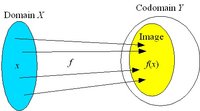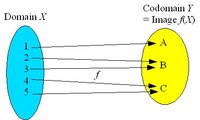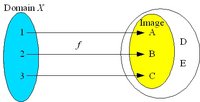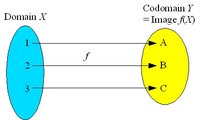Mapping
From Online Dictionary of Crystallography
Revision as of 18:48, 12 March 2009 by MassimoNespolo (talk | contribs)
Revision as of 18:48, 12 March 2009 by MassimoNespolo (talk | contribs)
The term mapping is often used in mathematics as a synonym of function. In crystallography it is particularly used to indicate a transformation.
Domain, image and codomain
A mapping f of X to Y (f : X → Y) acts on a domain X and the result is defined in the codomain Y of the function.The set of values f(X) is the image of the function. The image may span the whole codomain or be a subset of it.
Surjective, injective and bijective mappings
The mapping f is surjective (onto) if the image coincides with the codomain. The mapping is many-to-one because more than one element of the domain X can be mapped to the same element of the codomain Y, but all elements of Y are mapped to some elements of X. A surjective mapping is a surjection.



